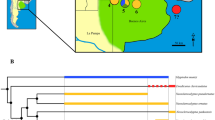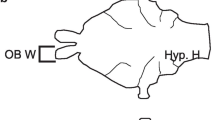Abstract
The glyptodonts (Mammalia: Cingulata) are characterized by an exoskeleton comprising most notably an armored tail and an immobile dorsal carapace formed by a large number of osteoderms. In 1889, Florentino Ameghino published the first phylogenetic scenario for the glyptodonts, based on the sequential application of two transformation series related to the morphology of the tail armor and carapace osteoderms. From the early to mid 1900s, several authors used Ameghino’s transformation series subordinated to a model of evolution in which derived glyptodont groups had arisen independently from separate pre-middle Miocene ancestors. This approach, in which the morphological states of Ameghino’s series were considered analogous rather than homologous, provided different phylogenetic scenarios and the paraphyletic classification still in use. Two recent cladistic analyses based on cranial and postcranial (including caudal tube) characters support the monophyly of glyptodonts and suggest novel intra-clade relationships. However, neither analysis included the classic osteoderm characters used by earlier authors. Therefore, we propose new osteoderm and carapace characters and evaluate their performance in a new cladistic analysis. We found that: a) some osteoderm characters used by earlier authors to support ancestor-descendent hypotheses are in fact fully homoplastic autapomorphies (e.g., multiplication of the number of rows of peripheral figures); b) characters previously believed to have originated independently in several groups (e.g., presence of caudal tube) are synapomorphies at a wider hierarchical level; c) some ancestor–descendant pre-cladistic hypotheses are incompatible with the topology and synapomorphy distribution obtained; and d) there is no reason to favor exoskeletal characters in glyptodont systematics.





Similar content being viewed by others
References
Ameghino F (1889) Contribución al conocimiento de los mamíferos fósiles de la República Argentina. Acad Nac Cienc Repúb Argent 6:1–1027
Ameghino F (1891) Mamíferos y aves fósiles argentinas. Especies nuevas adiciones y correcciones. Rev Argent Hist Nat 1:240–259
Burmeister G (1870–1874) Monografía de los glyptodontes en el Museo Público de Buenos Aires. Anal Mus Publ Buenos Aires 2:1–412
Cabrera A (1944) Los gliptodontoideos del araucaniano de Catamarca. Rev Mus La Plata Secc Paleontol 3:5–76
Carlini AA, Zurita AE, Scillato-Yané GJ, Sánchez T, Aguilera OA (2008) New glyptodont from the Codore Formation (Pliocene), Falcón State, Venezuela, its relationship with the Asterostemma problem, and the paleobiogeography of the Glyptodontinae. Paläontol Z 82:139–152
Castellanos A (1926) Sobre un nuevo gliptodóntido chapadmalense, Urotherium simplex n. gen. et n. sp. y las formas afines. Anal Mus Publ Buenos Aires 34:263–278
Castellanos A (1931) La librería del Glyptodon de Ameghino. Cultura 3 (23):4–9
Castellanos A (1932) Nuevos géneros de gliptodontes en relación con su filogenia. Physis 11:92–100
Castellanos A (1940) A propósito de los géneros Plohophorus, Nopachthus y Panochthus. Pub Inst Fis Geo Fac Cs Mat Fis Qui Nat 2:279–418
Castellanos A (1941) A propósito de los géneros Plohophorus, Nopachthus y Panochthus. Pub Inst Fis Geo Fac Cs Mat Fis Qui Nat 3:417–592
Castellanos A (1959) Trascendencia de la obra de Florentino Ameghino. Rev Fac Cs Nat Salta 1:35–56.
Croft DA, Flynn JJ, Wyss AR (2007) A new basal glyptodontid and other Xenarthra of the early Miocene Chucal Fauna, northern Chile. J Vertebr Paleontol 27:781–797
Darwin CR (1859) On the Origin of Species by Means of Natural Selection, or the Preservation of Favoured Races in the Struggle for Life. John Murray, London
Downing KF, White RS (1995) The cingulates (Xenarthra) of the Leisey Shell Pit local fauna (Irvingtonian), Hillsborough County, Florida. Bull Florida Mus Nat Hist 37:375–396
Fernicola JC (2008) Nuevos aportes para la sistemática de los Glyptodontia Ameghino 1889 (Mammalia, Xenarthra, Cingulata). Ameghiniana 45:553–574
Gaudin TJ, McDonald GH (2008) Morphology-based investigations of the phylogenetic relationships among extant and fossil xenarthrans. In: Vizcaíno SF, Loughry WJ (eds) The Biology of the Xenarthra. University of Florida Press, Gainesville, pp 24–36
Gaudin TJ, Wible JR (2006) The phylogeny of living and extinct armadillos (Mammalia, Xenarthra, Cingulata): a craniodental analysis. In: Carrano MT, Gaudin TJ, Blob RW, Wible JR (eds) Amniote Paleobiology: Perspectives on the Evolution of Mammals, Birds and Reptiles. University of Chicago Press, Chicago, pp 153–98
Goloboff PA, Farris JS, Nixon KC (2008) TNT, a free program for phylogenetic analysis. Cladistics 24:774–786
Hoffstetter R (1958) Xenarthra. In: Piveteau J (ed) Traité de Paléontologie, vol. 2, no. 6. Masson and Cie, Paris, pp 535–636
Krmpotic CM, Ciancio MR, Barbeito C, Mario RC, Carlini AA (2009) The species of Eutatus (Mammalia, Xenarthra): assessment, morphology and climate. Acta Zool 90:331–351
Lydekker R (1894) Contributions to a knowledge of the fossil vertebrates of Argentina, part 2, Extinct edentates of Argentina. Anal Mus La Plata 3:1–61
McKenna MC, Bell SK (1997) Classification of Mammals Above the Species Level. Columbia University Press, New York
McKenna MC, Wyss AR, Flynn J (2006) Paleogene pseudoglyptodont xenarthrans from central Chile and Argentine Patagonia. Am Mus Novitates 3536:1–8
Mones A (1986) Palaeovertebrata Sudamericana. Catálogo sistemático de los vertebrados fósiles de América del Sur. Parte I. Lista Preliminar y Bibliografía. Courier Forschungsinst Senckenberg 82:1–625
Paula Couto, C (1957) Sôbre um gliptodonte do Brasil. Dep Nac Prod Min Div Geol Min 165:1–37
Paula Couto C (1979) Tratado de Paleomastozoologia. Academia Brasileira de Ciências, Rio de Janeiro
Perea D (2005) Pseudoplohophorus absolutus n. sp. (Xenarthra, Glyptodontidae), variabilidad en Sclerocalyptinae y redefinición de una biozona del Mioceno Superior de Uruguay. Ameghiniana 42 (1):175–190
Porpino KO, Fernicola JC, Bergqvist LP (2009) A new cingulate (Mammalia: Xenarthra), Pachyarmatherium brasiliense sp. nov. from the late Pleistocene of northeastern Brazil. J Vertebr Paleontol 29:881–893
Porpino KO, Fernicola JC, Bergqvist LP (2010) Revisiting the intertropical Brazilian species Hoplophorus euphractus (Cingulata, Glyptodontoidea) and the phylogenetic affinities of Hoplophorus. J Vertebr Paleontol 30:911–927
Scillato-Yané GJ, Carlini AA, Tonni EP, Noriega JI (2005) Paleobiogeography of the late Pleistocene pampatheres of South America. J So Am Earth Sci 20:131–138
Scott WB (1903–1904) Mammalia of the Santa Cruz Beds. Paleontology. Part I Edentata. In: Scott WD (ed) Reports of the Princeton University Expeditions to Patagonia, 1896–1899. Princeton University, New Jersey. E. Schweizerbart’sche Verlagshandlung (E. Nägele), Stuttgart 5:1–364
Simpson GG (1945) The principles of classification and a classification of Mammals. Bull Am Mus Nat Hist 85:1–254
Simpson GG (1948) The beginning of the age of mammals in South America. I. Introduction: Marsupialia, Edentata, Condylarthra, Litopterna and Notioprogonia. Bull Am Mus Nat Hist 91:1–350
Wilkinson M (1992) Ordered versus unordered characters. Cladistics 8:375–385
Zurita EA, Aramayo SA (2007) New remains of Eosclerocalyptus tapinocephalus (Cabrera) (Mammalia Xenarthra Glyptodontidae): description and implications for its taxonomic status. Riv Ital Paleontol Strat 113:57–66
Acknowledgements
We are grateful to Timothy Gaudin and François Pujos for inviting us to participate in this volume, and to T. Gaudin and two anonymous reviewers for their interesting suggestions that improved the manuscript. This is a contribution to the grants, PICT 0143, UNLP N 647 and PIP-CONICET 1054 to Sergio F. Vizcaíno and UNLu CDD-CD 281-09 to Juan Carlos Fernicola. Kleberson O. Porpino would like to acknowledge CNPq for financial support (project 401825/2010-8).
Author information
Authors and Affiliations
Corresponding author
Appendices
Appendix I
Appendix II
List of new characters and character states added to the matrix of Porpino et al. (2010) and used in the cladistic analysis. Characters marked with an asterisk (*) are ordered.
-
01. External surface ornamentation of osteoderms: with figures defined by sulci (0); with a polygonal central area delimited by a dorsal thickening (1); without figures, smooth and perforated by large canals (2); without figures, presenting numerous small foramina associated with poorly developed sulci (3).
-
02*. Main figure defined by a principal sulcus and peripheral figures: near the posterior edge and peripheral figures absent or poorly developed at the posterior border (0); roughly central, surrounded by a single row of well-developed peripheral figures (1); roughly central, surrounded by at least two single rows of well-developed peripheral figures (2).
-
03. Outline of main figure defined by sulcus: circular or subcircular (0); roughly oblong (1).
-
04. Transverse mobile band(s): complete (extending from side to side of the carapace) (0); incomplete (limited to the ventrolateral border of the anterior region) or absent (1).
Appendix III
Rights and permissions
About this article
Cite this article
Fernicola, J.C., Porpino, K.O. Exoskeleton and Systematics: A Historical Problem in the Classification of Glyptodonts. J Mammal Evol 19, 171–183 (2012). https://doi.org/10.1007/s10914-012-9186-1
Published:
Issue Date:
DOI: https://doi.org/10.1007/s10914-012-9186-1




